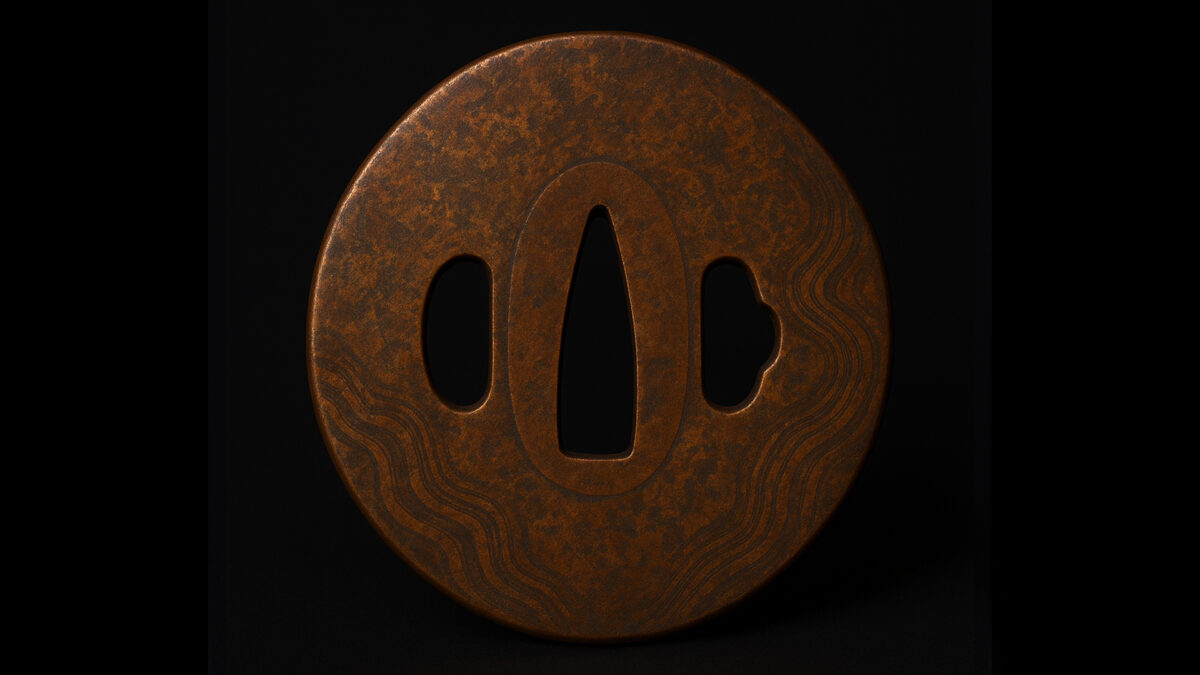- Mokume Gane as the Pinnacle of Traditional Technique and the Aesthetic Consciousness of the Samurai
- 1. Samurai Aesthetics and the Culture of Sword Ornamentation
- 2. Decorative Technique Embodying Samurai Aesthetic Values
- 3. Spread into Everyday Objects in the Late Edo Period
- 4. Transmission and Transformation into the Modern Era
- 5. Contemporary Relevance as Reflected in Samurai Culture and Mokume Gane
- Conclusion
Mokume Gane as the Pinnacle of Traditional Technique and the Aesthetic Consciousness of the Samurai
Introduction
Mokume Gane, a technique developed in the late 17th century by sword fitting artisan Juukichi Suzuki, stands as a symbolic craft of the samurai class. During the Edo period, as the sword shifted from battlefield weapon to a symbol of status and spirit, Mokume Gane evolved into a decorative technique that embodied “the soul of the samurai.” This article explores the intersection between samurai aesthetics and Mokume Gane, its cultural diffusion from sword fittings to daily objects, and the trajectory of its transmission—all from a scholarly perspective.
1. Samurai Aesthetics and the Culture of Sword Ornamentation
1-1. Sword Fittings as Symbols in a Peaceful Edo Japan
With the establishment of peace under the Tokugawa shogunate, swords became less functional as weapons and more symbolic of honor and authority. Samurai turned their attention from blades to sword fittings—tsuba (handguards), fuchi-gashira (collars and pommels), kozuka (small knife hilts)—leading to a flourishing culture of refined decoration and personal expression.
1-2. The Birth of Mokume Gane: A Leap in Sword Fitting Art
The carving technique known as guri-bori, originally from lacquerware, was adapted into metalwork. As this technique matured, craftsmen began carving through layered metals to reveal woodgrain-like patterns—thus Mokume Gane was born. Master craftsman Denbei Shoami applied this to sword fittings, creating intricate Mokume Gane patterns on tsuba and fuchi-gashira. (Wikipedia)
2. Decorative Technique Embodying Samurai Aesthetic Values
2-1. Sword Fittings as Expressions of Status and Individuality
Mokume Gane sword fittings served not only as adornments but as expressions of samurai individuality and taste. The metals used—gold, silver, shakudō, shibuichi—along with the patterns chosen, could hint at ideological leanings (pro-emperor or pro-shogunate), making Mokume Gane a subtle yet powerful medium of communication.
2-2. Fusion with Family Crests and Auspicious Motifs
Many tsuba incorporated family crests or auspicious designs. Mokume Gane’s unique layering technique was well suited to elevating such motifs, giving symbolic strength to what was both a protective and spiritual artifact.
3. Spread into Everyday Objects in the Late Edo Period
3-1. Expansion to Yatate, Kiseru, Inrō
By the late Edo period, sword-fitting artisans began applying Mokume Gane to everyday items such as yatate (portable writing sets), kiseru (smoking pipes), inrō (medicine cases), and netsuke (toggles). This shift aligned with the rise of urban merchant culture, indicating the samurai aesthetic had begun influencing townspeople’s daily lives.
3-2. Export and Commercialization in the Meiji Period
After the Meiji government’s Sword Abolishment Edict, samurai could no longer carry swords. Artisans redirected their skills toward wearable and exportable accessories—obi-dome, jewelry, buttons. Mokume Gane gained international recognition at events like the San Francisco and Paris Expositions, becoming synonymous with Japanese ornamental beauty.
4. Transmission and Transformation into the Modern Era
4-1. Technical Continuity Through the 20th Century
Although Mokume Gane declined after the Meiji era, it saw revival through the arts and crafts movement and international interest in metal arts. By the 1970s, it had reached overseas audiences through figures such as Norio Tamagawa, sparking renewed global engagement. (Wikipedia, James Binnion Metal Arts)
4-2. Modern Artisans Deepen the Technique
Contemporary artisans are now fusing Mokume Gane with modern themes and technologies. This commitment to creation within tradition reflects a “modern reinterpretation of samurai aesthetics.”
5. Contemporary Relevance as Reflected in Samurai Culture and Mokume Gane
- Spiritual Integration: Mokume Gane reflects the pride, status, and spirit of the samurai.
- Technical Contextualization: The technique embodies rigor and aesthetic perfection.
- Innovation and Inheritance: The challenge of continuing craftsmanship across generations.
- Cultural Resonance: A testament to how samurai values permeated everyday culture.
Conclusion
Within samurai society, Mokume Gane was not simply a metalworking technique—it was a cultural legacy infused with spirit. It remains a universal form of expression even today. It is hoped that this article illuminates, to the extent possible, the deep connections between samurai culture and Mokume Gane.
Note: Sources referenced are based on reliable craft materials and historical literature. However, documentation for some Edo-period examples and specific origins of certain pieces remains limited; such areas are designated “uncertain.” Detailed citations can be provided upon request.
References
(As in the original Japanese): Asahi Shimbun; Mainichi Shimbun; Jewelry Seasons Nos. 198–199; The Transmission of Mokume Gane Techniques; Metal Jewelry Craft (Art Manual Series); Works of Living National Treasure Norio Tamagawa; Traditional Metal Techniques (Katori, Iio, Ibuse); Chōkin & Tankin Techniques I–II; Wikipedia; Kinkō Tsuba (Kōgei Publishing); Ian Ferguson; Steve Midgett; Chris Ploof, etc.

